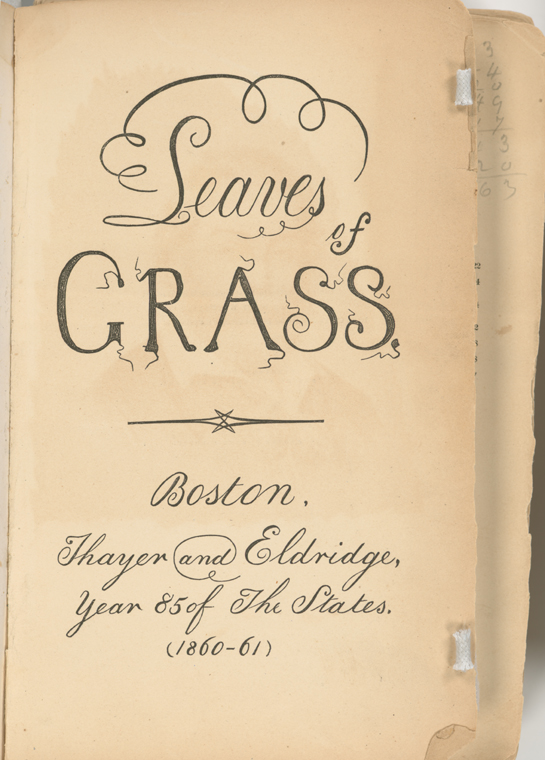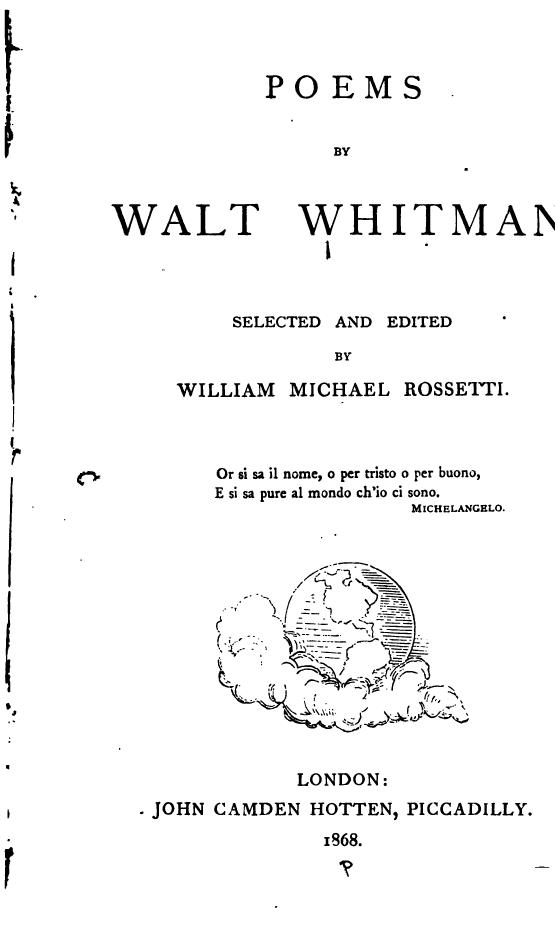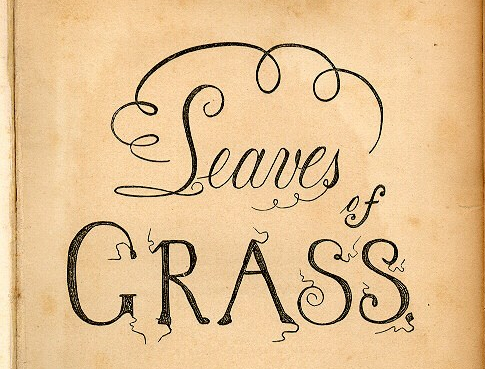Although John Addington Symonds’ strongest influences came from classical antiquity, he also drew substantial inspiration from books by some of his contemporaries. One noteworthy example is Leaves of Grass by Walt Whitman. Reading Leaves of Grass was a spiritual and artistic epiphany for Symonds; the book, and his understanding of Whitman, had a great influence on his writing and helped him formulate his thoughts on his own homosexual desires and ethics.
Symonds describes his first encounter with Whitman in the 1866-1875 section of his Memoirs. During that time, he wrote poetry as a “vehicle and safety-valve” for his feelings of same-sex attraction, which he called “tormenting preoccupations.”1 He discovered the book while he was spending time with his friend, F.W.H. Meyers. Meyers “stood up, seized a book and shouted out in his nasal intonation with those brazen lungs of his: ‘Long I thought that knowledge alone would content me.’” Symonds was quite taken with the work: “This fine poem,” he wrote, “omitted from later editions of Leaves of Grass, formed part of ‘Calamus’. The book became for me a sort of Bible.”2
Beyond this retroactive commemoration in the Memoirs, Symonds’ Whitman revelation can be dated more precisely by a letter from Symonds to his close friend Henry Graham Dakyns. Written on February 2, 1867 the letter he describes his first reaction to the book:
Leaves of Grass were published in 1860, when I was just 2 years old.3 Is it not strange I should only have read them this last week I am now 9 years old? Providence orders things so crookedly. If I had read them then & if I had understood I should have been a better very different man now. It is quite indispensable that you should have this book. Yet wait until I come & savor it for the first time with me. It is not a book; there are many better books; it is a man, miraculous in his vigour & love & omnigenuousness and omniscience & animalisme & omnivorous humanity [sic].4
In his letter, Symonds suggests he read Leaves of Grass a week or two before writing to Dakyns, at most, so his first encounter with the book must have occurred in the first month of 1867. Symonds was then 27 years old. He had already been involved in at least one same-sex affair, with choir boy William Fear Dyer, at Balliol College. However, Symonds ended the affair after a short time, and remained at odds with his own desires for many years after. He was aware of “social standards of propriety and respectability” that made homosexuality disallowed: at the same time, he was unable to ignore how he felt.5 Reading Leaves of Grass catalyzed for Symonds a sense of peace about his desires.

Unlike some texts, whose influence on Symonds is subtle and difficult to detect, Leaves of Grass is praised and discussed critically throughout the entirety of his Memoirs. At the end of the preface, there appears a quotation from Whitman’s poem “When I Read The Book,” which was part of his “Inscriptions” cluster in Leaves of Grass.
When I read the book, the biography famous,
And is this then (said I) what the author calls a man’s life?
And so will some one when I am dead and gone write my life?
(As if any man really knew aught of my life,
Why even I myself I often think know little or nothing of my real life,
Only a few hints, a few diffused faint clews and indirections
I seek for my own use to trace out here.)6
The “Inscriptions” quotation speaks many of the themes that Symonds drew from Whitman, and these are discussed in more depth later on in his autobiography. In Chapter 13, titled “Norman,” Symonds describes his relationship with his long time love Norman Moor. Norman Moor was a young man who Symonds met in Clifton 1868—a year after Symonds read Leaves of Grass.7 He says their time together “approached sincerity and truth mainly in those ‘native moments’” Symonds says.8 The phrase “native moments” shows up twice in the ‘Enfans d’Adam’ cluster of Leaves of Grass.9
Leaves of Grass also figures prominently in Chapter 15 of the Memoirs, on Symonds’ “Religious Development.” There is a lengthy section in which he waxes poetic about Leaves of Grass and its profound impact on him:
I find it difficult to speak about Leaves of Grass without exaggeration. Whitman’s intense emotional feeling for the universe, his acute sense of the goodliness of life in all its aspects, the audacity of his mood—as of one eager to cast himself upon illimitable billows, assured that whether he sank there or swam it would be well with him, confident the while that sink he could not, that nothing can eventually come to naught: this concrete passionate faith in the world, combined with the man’s multiform experience, his human sympathy, his thrill of love and comradeship, sent a current of vitalizing magnetism through my speculations… In short, Whitman added conviction, courage, self-reliance, to my sense of the Cosmic Enthusiasm. What is more, he taught me, as no enthusiasm of humanity could do, the value of fraternizing with my fellows—for their own sakes, to love them, to learn from them, to teach them, to help and to be helped by them—not for any ulterior object upon either side. I felt, through him, what it really is to be a member of the universe I sought to worship.10
In brief, the writings of Whitman played an important role in both Symonds self-conceptualization and spiritual life. But even more powerfully, Symonds states that Leaves of Grass, and in particular “Calamus,” played a direct role in his decision to write “A Problem in Greek Ethics.” The “Calamus” cluster in Leaves of Grass is a sequence of forty-five untitled poems that speak effusively of “comradeship” and “adhesive love,” terms which had been used in other contexts to indicate male same-sex love specifically.11 Even beyond this terminology, the poems were decisively provocative: one of them ends on the lines, “…two simple men I saw to-day on the pier…The one to remain hung on the other’s neck and passionately kiss’d him, / While the one to depart tightly prest the one to remain in his arms.”12 It is hard to conjure an interpretation of these lines that is not referential to homosexual desire. Symonds describes the influence of these poems in Memoirs:
Inspired by ‘Calamus’ I adopted another method of palliative treatment, and tried to invigorate the emotion I could not shake off by absorbing Whitman’s conception of comradeship… I can now declare with sincerity that my abnormal inclinations, modified by Whitman’s idealism and penetrated with his democratic enthusiasm, have brought me into close and profitable sympathy with human beings even while I sinned against law and conventional morality. The immediate result of this study of Walt Whitman was the determination to write the history of paiderastia in Greece and to attempt a theoretical demonstration of the chivalrous enthusiasm which seemed to me implicit in comradeship.”13
Symonds encountered at least four different editions of Leaves of Grass throughout his life. The edition that he received from Meyers was the third edition, published in 1860-1861 by Boston publisher Thayer and Eldridge.14 We know this because of the publication date Symonds offers Dakyns, as well as the opinions he expresses about other editions. This edition contained the full, forty-five poem “Calamus” cluster in its original sequence.
In the Memoirs, Symonds quotes from three different U.S. editions of Leaves of Grass: the aforementioned 1860 version, as well as the 1856 second edition and the 1867 fourth edition. Whitman often made substantial edits, sometimes adding full sections of poems, between editions, which is why it is possible to determine exactly which version Symonds quoted from. The 1856 edition, among other differences, notably did not include the “Calamus” cluster, and in the 1867 edition “Calamus” had been edited down to thirty-nine poems.15, 16
In addition to the three US editions, Symonds got his hands on the first UK edition of the book…sort of. William Rossetti, a literary critic and biographer, wanted to publish an edition of Leaves of Grass. However, he was concerned about the UK’s anti-pornography laws, and omitted poems he thought would upset the public. The book, titled Poems by Walt Whitman,was published in in 1868 with John Camden Hotten. Hotten specialized in controversial titles, but the new volume nonetheless omitted nearly half of the poems.17 After the publication of the book, Symonds wrote to Rossetti to inquire why he had cut certain poems—including “Calamus.”18 It is notable that by early 1868, Symonds was already knowledgeable enough about the “Calamus” poems to notice their absence.

Symonds is not shy about his influences; the majority of his work, in fact, draws quite explicitly on other texts. However, he speaks of no modern book quite as effusively or clearly as he does Leaves of Grass. Symonds would carry his love of Whitman with him throughout his life, and it ultimately culminated in the writing of Walt Whitman: A Study, published in 1893.
EXTERNAL LINKS
Leaves of Grass (1856)
Leaves of Grass (1860)
Leaves of Grass (1867)
Poems by Walt Whitman (1868)
ENDNOTES
1 John Addington Symonds and Amber K. Regis, ed., The Memoirs of John Addington Symonds: a Critical Edition, (London: Palgrave Macmillan, 2016), 367.
2 Symonds and Regis, Memoirs, 367.
3 Symonds cites the incorrect original publication date for Leaves of Grass. It was first published in 1855, although Symonds probably did not read this edition, as he does not mention or cite it.
4 John Addington Symonds, Herbert M. Schueller, ed. and Robert Peters, ed., The Letters of John Addington Symonds, vol. 1 (Detroit: Wayne State University Press, 1967), 696.
5 Symonds and Regis, Memoirs, 10.
6 Ibid, 60.
7 Ibid, 379.
8 Ibid, 403.
9 Ibid, 413n.
10 Ibid, 468.
11 James E. Miller, “Whitman’s “Calamus”: The Leaf and the Root,” PMLA 72. 1 (1957): 251, doi:10.2307/460228.
12 Walt Whitman, Leaves of Grass, (Boston: Thayer and Eldridge, 1860), 373.
13 Symonds and Regis, Memoirs, 368.
14 Gregory Eiselein, J.R. LeMaster, ed., and Donald D. Kummings, ed.,“Leaves of Grass, 1860 edition,” Walt Whitman: An Encyclopedia (New York: Garland Publishing, 1998), https://whitmanarchive.org/criticism/current/encyclopedia/entry_23.html.
15 Harold Aspiz, J.R. LeMaster, ed., and Donald D. Kummings, ed.,“ “Leaves of Grass, 1856 edition,” Walt Whitman: An Encyclopedia (New York: Garland Publishing, 1998), https://whitmanarchive.org/criticism/current/encyclopedia/entry_22.html.
16 Luke Mancuso, J.R. LeMaster, ed., and Donald D. Kummings, ed.,“ “Leaves of Grass, 1867 edition,” Walt Whitman: An Encyclopedia (New York: Garland Publishing, 1998), https://whitmanarchive.org/criticism/current/encyclopedia/entry_24.html.
17 Kenneth M. Price and Ed Folsom, “Published Works,” The Walt Whitman Archive, University of Nebraska–Lincoln and University of Iowa, May 2019, https://whitmanarchive.org/published/books/other/british/intro.html.
18 Symonds, Schueller, and Peters, Letters, 836n.
WORKS CITED
Aspiz, Harold. “Leaves of Grass, 1856 edition.” 1998. J.R. Edited by LeMaster and Donald D. Kummings. Walt Whitman: An Encyclopedia. New York: Garland Publishing. https://whitmanarchive.org/criticism/current/encyclopedia/entry_22.html.
Eiselein, Gregory. “Leaves of Grass, 1860 edition.” 1998. J.R. Edited by LeMaster and Donald D. Kummings. Walt Whitman: An Encyclopedia. New York: Garland Publishing. https://whitmanarchive.org/criticism/current/encyclopedia/entry_23.html.
Mancuso, Luke. “Leaves of Grass, 1867 edition.” 1998. J.R. Edited by LeMaster and Donald D. Kummings. Walt Whitman: An Encyclopedia. New York: Garland Publishing. https://whitmanarchive.org/criticism/current/encyclopedia/entry_24.html.
Miller, James E. “Whitman’s “Calamus”: The Leaf and the Root.” 1957. PMLA 72, no. 1: 249-71. doi:10.2307/460228.
Price, Kenneth M. and Ed Folsom, eds. “Published Works.” The Walt Whitman Archive. University of Nebraska–Lincoln and University of Iowa, May 2019. https://whitmanarchive.org/published/books/other/british/intro.html.
Symonds, John Addington. 1967. The Letters of John Addington Symonds. Volume 1. Edited by Herbert M. Schueller and Robert Peters. Detroit: Wayne State University Press.
Symonds, John Addington. 2016. The Memoirs of John Addington Symonds: A Critical Edition. Edited by Amber K. Regis. London: Palgrave Macmillan.
Whitman, Walt. 1860. Leaves of Grass. Boston: Thayer and Eldridge.

